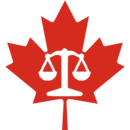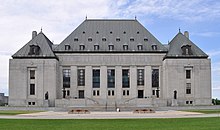| Part of a series on |
| Canadian law |
|---|
 |

The legal system of Canada is pluralist: its foundations lie in the English common law system (inherited from its period as a colony of the British Empire), the French civil law system (inherited from its French Empire past),[1][2] and Indigenous law systems[3] developed by the various Indigenous Nations.[4][5]
The Constitution of Canada is the supreme law of the country, and consists of written text and unwritten conventions.[6] The Constitution Act, 1867 (known as the British North America Act prior to 1982), affirmed governance based on parliamentary precedent and divided powers between the federal and provincial governments.[7] The Statute of Westminster 1931 granted full autonomy, and the Constitution Act, 1982 ended all legislative ties to Britain, as well as adding a constitutional amending formula and the Canadian Charter of Rights and Freedoms.[8] The Charter guarantees basic rights and freedoms that usually cannot be over-ridden by any government—though a notwithstanding clause allows Parliament and the provincial legislatures to override certain sections of the Charter for a period of five years.[9]
Canada's judiciary plays an important role in interpreting laws and has the power to strike down Acts of Parliament that violate the constitution. The Supreme Court of Canada is the highest court and final arbiter and has been led since December 18, 2017, by Richard Wagner, the Chief Justice of Canada.[10] Its nine members are appointed by the governor general on the advice of the prime minister and minister of justice. All judges at the superior and appellate levels are appointed after consultation with non-governmental legal bodies. The federal Cabinet also appoints justices to superior courts in the provincial and territorial jurisdictions.[11] Common law prevails everywhere except in Quebec, where civil law predominates.[12] Criminal law is solely a federal responsibility and is uniform throughout Canada.[13] Law enforcement, including criminal courts, is officially a provincial responsibility, conducted by provincial and municipal police forces.[14] However, in most rural areas and some urban areas, policing responsibilities are contracted to the federal Royal Canadian Mounted Police.[15]
Canadian Aboriginal law provides certain constitutionally recognized rights to land and traditional practices for Indigenous groups in Canada.[16] Various treaties and case laws were established to mediate relations between Europeans and many Indigenous peoples.[17] These treaties are agreements between the Canadian Crown-in-Council with the duty to consult and accommodate.[18] Indigenous law in Canada refers to the legal traditions, customs, and practices of Indigenous Nations and communities.[19][20]
- ^ "Where our legal system comes from - About Canada's System of Justice". September 7, 2016.
- ^ John Dickinson; Brian Young (2014). A Short History of Quebec. McGill-Queen's University Press. p. 59. ISBN 978-0-7735-7530-1.
- ^ Borrows, John (2005). "Indigenous Legal Traditions in Canada". Washington University Journal of Law & Policy. 19: 167–224. Retrieved May 23, 2022.
As has already been noted, numerous indigenous legal traditions continue to function in Canada in a systematically important way. Canada would better be described as multi-juridicial or legally pluralistic.
- ^ Anaya, James (2007). "Indigenous Law and Its Contribution to Global Pluralism". Indigenous Law Journal. 6 (1). HeinOnline: 3–12. Retrieved January 26, 2022.
- ^ Hunt, Sarah Elizabeth (2014). Witnessing the Colonialscape: lighting the intimate fires of Indigenous legal pluralism (PhD). Simon Fraser University. Retrieved January 25, 2022.
- ^ Dodek, Adam (2016). The Canadian Constitution. Dundurn – University of Ottawa Faculty of Law. p. 13. ISBN 978-1-4597-3505-7.
- ^ Olive, Andrea (2015). The Canadian Environment in Political Context. University of Toronto Press. pp. 41–42. ISBN 978-1-4426-0871-9.
- ^ Bhagwan, Vishnoo; Vidya, Bhushan (2004). World Constitutions. Sterling Publishers. pp. 549–550. ISBN 978-81-207-1937-8.
- ^ Bakan, Joel; Elliot, Robin M (2003). Canadian Constitutional Law. Emond Montgomery Publications. pp. 3–8, 683–687, 699. ISBN 978-1-55239-085-6.
- ^ "Current and Former Chief Justices". Supreme Court of Canada. December 18, 2017. Archived from the original on January 16, 2018. Retrieved January 16, 2018.
- ^ Yates, Richard; Bain, Penny; Yates, Ruth (2000). Introduction to Law in Canada. Prentice Hall Allyn and Bacon Canada. p. 93. ISBN 978-0-13-792862-0.
- ^ Hermida, Julian (May 9, 2018). Criminal Law in Canada. Kluwer Law International B.V. pp. 10–. ISBN 978-90-411-9627-9.
- ^ Sworden, Philip James (2006). An introduction to Canadian law. Emond Montgomery Publications. pp. 22, 150. ISBN 978-1-55239-145-7.
- ^ "Who we are". Ontario Provincial Police. 2009. Archived from the original on August 26, 2016. Retrieved October 24, 2012.
- ^ Royal Canadian Mounted Police. "Keeping Canada and Our Communities Safe and Secure" (PDF). Queen's Printer. Archived from the original (PDF) on July 6, 2011. Retrieved May 23, 2011.
- ^ Reynolds, Jim (2015). Aboriginal Peoples and the Law: A Critical Introduction. UBC Press. ISBN 978-0-7748-8023-7.
- ^ Patterson, Lisa Lynne (2004). Aboriginal roundtable on Kelowna Accord: Aboriginal policy negotiations 2004–2006 (PDF) (Report). 1. Parliamentary Information and Research Service, Library of Parliament. p. 3. Archived (PDF) from the original on November 26, 2014. Retrieved October 23, 2014.
- ^ Isaac, Thomas (2012). Aboriginal Law (4th ed.). UBC Press. p. 349. ISBN 978-1-895830-65-1.
- ^ John Borrows (2006). "Indigenous Legal Traditions in Canada" (PDF). Report for the Law Commission of Canada. Law Foundation Chair in Aboriginal Justice and Governance Faculty of Law, University of Victoria.
In Canada, Indigenous legal traditions are separate from but interact with common law and civil law to produce a variety of rights and obligations for Indigenous people....Many Indigenous societies in Canada possess legal traditions. These traditions have indeterminate status in the eyes of many Canadian institutions.
- ^ Kaufman, Amy. "Research Guides: Aboriginal Law & Indigenous Laws: A note on terms". guides.library.queensu.ca.
Indigenous law exists as a source of law apart from the common and civil legal traditions in Canada. Importantly, Indigenous laws also exist apart from Aboriginal law, though these sources of law are interconnected. Aboriginal law is a body of law, made by the courts and legislatures, that largely deals with the unique constitutional rights of Aboriginal peoples and the relationship between Aboriginal peoples and the Crown. Aboriginal law is largely found in colonial instruments (such as the Royal Proclamation of 1763, the Constitution Acts of 1867 and 1982 and the Indian Act) and court decisions, but also includes sources of Indigenous law. "Indigenous law consists of legal orders which are rooted in Indigenous societies themselves. It arises from communities and First Nation groups across the country, such as Nuu Chah Nulth, Haida, Coast Salish, Tsimshian, Heiltsuk, and may include relationships to the land, the spirit world, creation stories, customs, processes of deliberation and persuasion, codes of conduct, rules, teachings and axioms for living and governing.